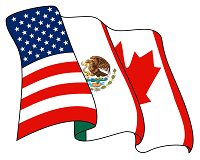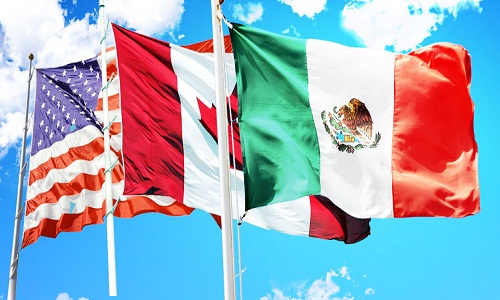"Industry veterans met for the fourth round of NAFTA trade agreement in Washington from October 11–17 and the spotlight was on the US trade agreement with Central America. Central America is a big player in the apparel industry, exporting most of its production to the US. The region is a top manufacturer of basic T-shirts, underwear, sweatshirts, pants, synthetic activewear and socks. Employing thousands of workers, factories there cut & sew t-shirts for Target and Walmart as well as for several Los Angeles clothing companies such as Jerry Leigh."

Industry veterans met for the fourth round of NAFTA trade agreement in Washington from October 11–17 and the spotlight was on the US trade agreement with Central America. Central America is a big player in the apparel industry, exporting most of its production to the US. The region is a top manufacturer of basic T-shirts, underwear, sweatshirts, pants, synthetic activewear and socks. Employing thousands of workers, factories there cut & sew t-shirts for Target and Walmart as well as for several Los Angeles clothing companies such as Jerry Leigh.

The difference between Central America and NAFTA is that the US has a $5 billion trade surplus when dealing with the DR-CAFTA countries while the US has a $74 billion deficit when dealing with its NAFTA partners, Mexico and Canada. From Canada, the United States imports a lot of crude oil and natural gas. From Mexico, it brings in a large number of cars, trucks and auto parts. That means that a renegotiated DR-CAFTA may not be as drastic as it could be with NAFTA. Gail Strickler, former assistant US trade representative for textiles under the Obama administration and now president of global trade at Brookfield Associates in Washington, D.C says they export about $29 million in goods to CAFTA countries and import about $24 billion. According to him, no one can jeopardise the trade potential of $5 billion surplus. For some, CAFTA negotiations will harp on intellectual-property protection and digital commerce.
Improving trade
Trade facilitation can also be one of the areas of focus as the US administration would like to speed up customs processing in Central America, improve training of customs officials at the borders, and reduce corruption at customs-entry points and at the ports. Julie Hughes, President, US Fashion Industry Association, feels NAFTA is being renegotiated first as that will have a big impact on what may or may not be discussed relating to CAFTA. Right now, one of the sticking points in the NAFTA renegotiations is trade-preference levels, also known as TPLs. TPLs allow for a certain amount of yarn and fabric produced outside the free-trade-agreement region to be used in apparel production as long as the non-regional inputs are cut and sewn within the free-trade countries.
Agenda of discussion
Overall, Mexico and Canada combined are permitted to use nearly 236 million sq m. equivalents (SME) of apparel, made-ups and fabric and 12.8 million kg of yarn containing third-party components. US textile companies would like to see this regulation disappear but the Mexicans, who use it more than the Canadians, want it to remain. Many US clothing manufacturers that produce in Mexico and Canada would like to see TPL levels increased rather than reduced because it would lower their production costs.
Steve Lamar, Executive VP, AAFA, noted TPLs often help retain duty-free status that might be eliminated. For example, if there were no TPLs, US clothing manufacturers could not use foreign-made linings in US-made garments and get duty-free access to Canada or Mexico. Hardly any coat linings are manufactured in the US. Using Chinese or Italian lining would disqualify the entire garment from duty-free status even if it is made of US fabric and sewn in the US. If we keep the TPLs, you get that duty-free qualification, added Lamar.
Aspects industry wants to be changed
Central American clothing factories demands some duty-free transfer of certain amount of fabric made in Central America to Mexico, where it could be cut and sewn and exported to the United States and Canada. This is similar to a provision, cumulation, allowing 100 m. sq. m. equivalents of fabric to be sent from Mexico to Central America to be cut and sewn and then shipped duty-free to the United States. Most of the fabric shipped from Mexico to Central America is denim for blue jeans and also includes wool, cotton and man-made fiber bottom-weight cloth. Having said that, the US textile industry feels it would cut into the nearly $3 billion in cotton, yarn and fabric it sends every year to the DR-CAFTA countries.












